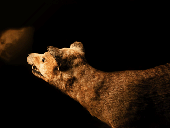The Zoological Museum Collection

Widely recognized as a significant collection of national and international importance, the Zoological Museum of today, through its rich historical and cultural diversity represents an important entity. The collection contains representatives of all the animal phyla, from tiny protozoa, to large mammals and fulfils a significant teaching, research and educational role both within college and to the wider community. Records show that the general collection is over 150 years old. There are many examples of extinct and endangered species (including Ireland's Last Great Auk) and there are over 12,000 insect specimens in an entomological collection of renowned scientific value. In particular, the Murray insect collections contain 336 national records. This collection has been heavily drawn upon for national records going back to the Baynes revised catalogue of Irish Macrolepidoptera of 1964. These records are a clear indication of how nationally important the collection remains today. The Museum is further enhanced by a collection of hand-made glass models prepared by the famous Blaschka family (c. 1860).
Given its historical background, its connections with noted college academics, stretching back over 200 years and private collectors, the collection as a whole represent a unique resource among Irish and most British Universities. Individual specimens and specific collections are of significant national and international importance.

The Museum cares for a wide range of material that is worldwide in scope and diverse in quality. Most of the continents and ocean basins are represented by specimens and collections in various forms (dry mounts, skeletal, wet and slide mounted). The diversity and quality of the material, is unique among Irish (and most British universities) and provides a non-renewable resource of scientific, educational and cultural significance. Through the parameters and themes of its Collection Policy (2012), the Museum accepts and collects material within a defined framework of education, teaching and research interests.

